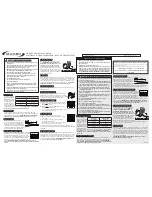
Refer All Communications to the Nearest
Ingersoll–Rand Office or Distributor.
Ingersoll–Rand Company 2000
Printed in Japan
03539509
Form P7078
Edition 5
June, 2000
OPERATION AND MAINTENANCE MANUAL FOR
MODELS 2400P AND 3000P
TWIN BLADE IMPULSE WRENCHES
Models 2400P and 3000P Impulse Wrenches are designed for assembly operations
which require high speed rundown of fasteners with consistent torque delivery and
reduced torque reaction.
Ingersoll–Rand is not responsible for customer modification of tools for applications on
which Ingersoll–Rand was not consulted.
IMPORTANT SAFETY INFORMATION ENCLOSED.
READ THIS MANUAL BEFORE OPERATING TOOL.
IT IS THE RESPONSIBILITY OF THE EMPLOYER TO PLACE THE INFORMATION
IN THIS MANUAL INTO THE HANDS OF THE OPERATOR.
FAILURE TO OBSERVE THE FOLLOWING WARNINGS COULD RESULT IN INJURY.
PLACING TOOL IN SERVICE
•
Always operate, inspect and maintain this tool in
accordance with American National Standards
Institute Safety Code for Portable Air Tools
(ANSI B186.1).
•
For safety, top performance, and maximum
durability of parts, operate this tool at 90 psig
(6.2 bar/620 kPa) maximum air pressure at the inlet
with 1/2” (13 mm) inside diameter air supply hose.
•
Always turn off the air supply and disconnect the
air supply hose before installing, removing or
adjusting any accessory on this tool, or before
performing any maintenance on this tool.
•
Do not use damaged, frayed or deteriorated air
hoses and fittings.
•
Be sure all hoses and fittings are the correct size
and are tightly secured. See Dwg. TPD905–1 for a
typical piping arrangement.
•
Always use clean, dry air at 90 psig
(6.2 bar/620 kPa) maximum air pressure. Dust,
corrosive fumes and/or excessive moisture can ruin
the motor of an air tool.
•
Do not lubricate tools with flammable or volatile
liquids such as kerosene, diesel or jet fuel.
•
Do not remove any labels. Replace any damaged
label.
USING THE TOOL
•
Always wear eye protection when operating or
performing maintenance on this tool.
•
Always wear hearing protection when operating
this tool.
•
Keep hands, loose clothing and long hair away from
rotating end of tool.
•
Anticipate and be alert for sudden changes in
motion during start up and operation of any power
tool.
•
Keep body stance balanced and firm. Do not
overreach when operating this tool. High reaction
torques can occur at or below the recommended air
pressure.
•
Tool shaft may continue to rotate briefly after
throttle is released.
•
Air powered tools can vibrate in use. Vibration,
repetitive motions or uncomfortable positions may
be harmful to your hands and arms. Stop using any
tool if discomfort, tingling feeling or pain occurs.
Seek medical advice before resuming use.
•
Use accessories recommended by Ingersoll–Rand.
•
Use only impact sockets and accessories. Do not use
hand (chrome) sockets or accessories.
•
This tool is not designed for working in explosive
atmospheres.
•
This tool is not insulated against electric shock.
The use of other than genuine Ingersoll–Rand replacement parts may result in safety hazards, decreased tool
performance, and increased maintenance, and may invalidate all warranties.
Repairs should be made only by authorized trained personnel. Consult your nearest Ingersoll–Rand Authorized
Servicenter.
F
E
P


































